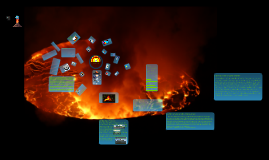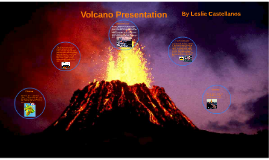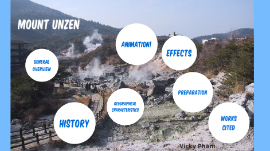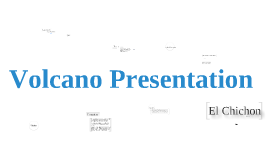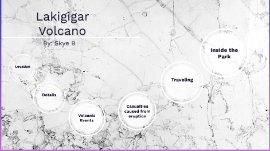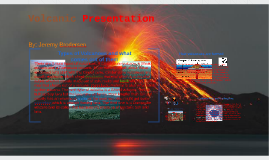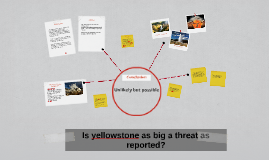Volcano Presentation
Transcript: Earth Science Project By Rafael Martinez-Salas Describing the Layers of the Earth The inner core is a solid section of the Earth and is unattached to the mantle, being suspended by the molten outer core. This solidified state is the result of a very intense pressure-freezing process that occurs in most liquids when temperature decreases or pressure increases. The outer core of Earth is a scorching hot, electrically conductive liquid in which convection takes place. This inner layer in mutual combination with the rotational motion of the Earth creates a dynamo effect where a force field of electrical currents is generated. This field is also known as Earth's magnetic field, which is responsible for the functioning of mechanical and biological compasses. This field also causes a subtle jerking motion in the Earth's daily rotation. In terms of the physical aspects of the outer core, the layer is dense, but not as dense as pure molten iron, evidencing the presence of multiple impurities having a lighter chemical makeup. According to scientists, about 10% of this layer is composed of sulfur and/or oxygen due to the fact that these two elements are abundant in the cosmos and dissolve readily in molten iron. The outer core is in the range of 200 to 300 kilometers (125 to 188 miles) thick and represents about 4% of the mantle-crust mass. This layer is sometimes identified as part of the lower mantle due to its geographical nature. However, studies on seismic discontinuities suggest that this "D" layer might differ chemically from the lower mantle lying above it. Looking at the lower mantle, its chemical composition includes silicon, magnesium, and oxygen. Most likely, it probably also contains some iron, calcium, and aluminum. This layer is comprised of 72.9% of the mantle-crust mass, making the Earth abundant in the chemical elements of silicon, magnesium and oxygen, the layer's primary components. The next layer, the Transition region comprises 7.5% of Earth's mass with a depth of 250-406 miles (400-650 kilometers). This layer is also known as the mesosphere and is 11.1% of the mantle-crust. It is made of mainly basaltic magmas with amounts of calcium, aluminum and garnet (an aluminum-bearing silicate mineral). The layer becomes dense when the garnet mineral cools but is buoyant and light when subject to heat due to the low melting points. The outer most layer, the crust, is categorized into two parts, the Oceanic crust and the continental crust. The Oceanic crust is the smallest part of Earth, only 0.099% of its mass and reaching a small depth of 0-6 miles (0-10 kilometers). In the beginning of time, it was possible that this area did not exist for through frequent volcanic activity does only the crust form. Evidence of this is marked by the oceanic ridge system, which is a 25,000 mile (40,000-kilometer) array of many volcanoes which creates layer after layer of new crust at the rate of 17 km3 per year. The ocean floor is covered in basalt originating from volcanic activity and as a matter of fact, Iceland and Hawaii are two island systems that emerged from the accumulated basalt. Continental crust: The second smallest area of the Earth is the Continental crust, making up only 0.374% of the Earth's mass and extending a short depth of 0 - 31 miles (0-50 kilometers). Looking at the percent by composition, the continental crust makes up only 0.554% of the mantle-crust mass. The layer is composed primarily of crystalline rocks made of low-density buoyant minerals dominated mostly by quartz (SiO2 aka Silica) and fieldspars (metal-poor silicates). This is the outer part of the Earth composed essentially of crystalline rocks. The continental crust and the oceanic crust are also referred to as the lithosphere because of the cool and rocky conditions that exist in its chemical composition. Pieces of Evidence that Support the Continental Drift Theory Magma rises and spreads the sea floor. At the boundary between the plates, the ocean floor sinks, but at the same time is pushing against the continents. At the plates move, most of the geological structures and events we are familiar with occur, including earthquakes and volcanoes. Plate tectonics a major theory explaining the dynamics of our planet Earth and our understanding would not have been the same without it. In the 1960's a gentleman by the name of Harry Hess proposed that not only were the continents moving, but the sea floor was also moving. Motion of the sea floor in a conveyor belt fashion explains the phenomena of the youngest rocks being found only at the mid-ocean ridges, and the rocks get progressively older as you move away from the ridge. If the sea floor is spreading, then clearly the continents could diverge from one another. The rock of the sea floor also exhibited magnetic properties. Not only did the magnetism of these rocks change over time, they completely reversed which supported the motion of the magnetic poles. Hess's explanation of the motion of






